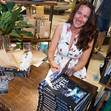Zena Shapter's Blog, page 19
March 6, 2017
How @MargoLanagan Signs Books
 What kind of books does Margo Lanagan write?
What kind of books does Margo Lanagan write?Fantasy and YA.
Tell me more!
 Margo Lanagan is an internationally acclaimed writer of novels and short stories. Her latest novel is Zeroes, the first book of the Zeroes trilogy (YA fantasy), a collaboration with Scott Westerfeld and Deborah Biancotti. Her novel Sea Hearts is published as The Brides of Rollrock Island in the UK and the US, and it won the CBCA Book of the Year, WA Premier’s Literay Award, Aurealis Award and Barbara Jefferis Award, and was shortlisted for the Adelaide Festival Award for Literature, NSW Premier Literay Awards, Queensland Literary Awards among others. Her novel Tender Morsels won the World Fantasy Award for Best Novel and was a Michael L. Printz Honor Book for Excellence in Young Adult Literature. She’s also written Tender Morsels and five short story collections: White Time, Black Juice, Red Spikes, Yellowcake and Cracklescape. Black Juice was a Michael L. Printz Honor Book, won two World Fantasy Awards and the Victorian Premier’s Award for Young Adult Fiction. Red Spikes won the CBCA Book of the Year: Older Readers, was a Publishers Weekly Best Book of the Year, a Horn Book Fanfare title, was shortlisted for the Commonwealth Writer’s Prize and longlisted for the Frank O’Connor International Short Story Award. Margo lives in Sydney.
Margo Lanagan is an internationally acclaimed writer of novels and short stories. Her latest novel is Zeroes, the first book of the Zeroes trilogy (YA fantasy), a collaboration with Scott Westerfeld and Deborah Biancotti. Her novel Sea Hearts is published as The Brides of Rollrock Island in the UK and the US, and it won the CBCA Book of the Year, WA Premier’s Literay Award, Aurealis Award and Barbara Jefferis Award, and was shortlisted for the Adelaide Festival Award for Literature, NSW Premier Literay Awards, Queensland Literary Awards among others. Her novel Tender Morsels won the World Fantasy Award for Best Novel and was a Michael L. Printz Honor Book for Excellence in Young Adult Literature. She’s also written Tender Morsels and five short story collections: White Time, Black Juice, Red Spikes, Yellowcake and Cracklescape. Black Juice was a Michael L. Printz Honor Book, won two World Fantasy Awards and the Victorian Premier’s Award for Young Adult Fiction. Red Spikes won the CBCA Book of the Year: Older Readers, was a Publishers Weekly Best Book of the Year, a Horn Book Fanfare title, was shortlisted for the Commonwealth Writer’s Prize and longlisted for the Frank O’Connor International Short Story Award. Margo lives in Sydney.
Where can I find out even more about this fabulous author?
http://amongamidwhile.blogspot.com.au/
What does her handwriting reveal?
Compare her swirls and slants to the letters and revelations here, then scroll to check out your next author!
March 5, 2017
How @JackMDann Signs Books
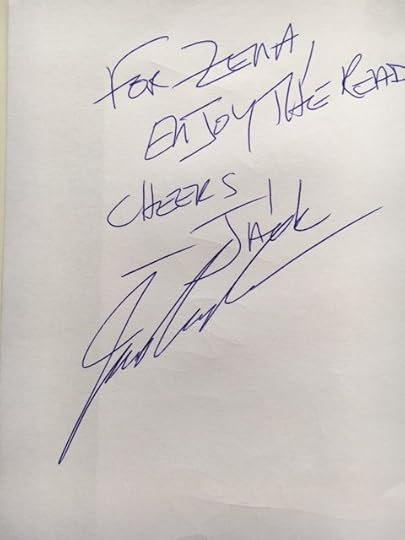 What kind of books does Jack Dann write?
What kind of books does Jack Dann write?Science fiction and anthologies.
Tell me more!
 JACK DANN is a multiple award winning author who has written or edited over seventy books, including the groundbreaking novels Junction, Starhiker, The Man Who Melted, The Memory Cathedral – which is an international bestseller, the Civil War novel The Silent, and Bad Medicine, which has been compared to the works of Jack Kerouac and Hunter S. Thompson and called “the best road novel since the Easy Rider days.” He is a recipient of the Nebula Award, the Australian Aurealis Award (twice), the Ditmar Award (three times), the World Fantasy Award, the Peter McNamara Achievement Award, the Peter McNamara Convenors Award for Excellence, and the Premios Gilgamés de Narrativa Fantasticaaward. Dann has also been honoured by the Mark Twain Society (Esteemed Knight). Dann lives in Australia on a farm overlooking the sea and ‘commutes’ back and forth to Los Angeles and New York.
JACK DANN is a multiple award winning author who has written or edited over seventy books, including the groundbreaking novels Junction, Starhiker, The Man Who Melted, The Memory Cathedral – which is an international bestseller, the Civil War novel The Silent, and Bad Medicine, which has been compared to the works of Jack Kerouac and Hunter S. Thompson and called “the best road novel since the Easy Rider days.” He is a recipient of the Nebula Award, the Australian Aurealis Award (twice), the Ditmar Award (three times), the World Fantasy Award, the Peter McNamara Achievement Award, the Peter McNamara Convenors Award for Excellence, and the Premios Gilgamés de Narrativa Fantasticaaward. Dann has also been honoured by the Mark Twain Society (Esteemed Knight). Dann lives in Australia on a farm overlooking the sea and ‘commutes’ back and forth to Los Angeles and New York.
Where can I find out even more about this fabulous author?
What does his handwriting reveal?
Compare his swirls and slants to the letters and revelations here, then scroll to check out your next author!
March 4, 2017
How @IanIrvineAuthor Signs Books

What kind of books does Ian Irvine write?
Mostly epic fantasy, but also children’s fiction, and some SF (eco-thrillers).
Tell me more!
 Ian Irvine, an Australian marine scientist, has also written 32 novels and an anthology of shorter stories. His novels include the Three Worlds fantasy sequence (The View from the Mirror, The Well of Echoes and Song of the Tears), which has been published in many countries and translations and has sold over sold over a million copies, a trilogy of eco-thrillers in a world of catastrophic climate change, Human Rites, now in its third edition, and 13 novels for younger readers. His latest book is The Summon Stone, Book 1 of The Gates of Good and Evil, published in the US, UK and Australia by Orbit Books in May 2016.
Ian Irvine, an Australian marine scientist, has also written 32 novels and an anthology of shorter stories. His novels include the Three Worlds fantasy sequence (The View from the Mirror, The Well of Echoes and Song of the Tears), which has been published in many countries and translations and has sold over sold over a million copies, a trilogy of eco-thrillers in a world of catastrophic climate change, Human Rites, now in its third edition, and 13 novels for younger readers. His latest book is The Summon Stone, Book 1 of The Gates of Good and Evil, published in the US, UK and Australia by Orbit Books in May 2016.
Where can I find out even more about this fabulous author?
https://www.facebook.com/ianirvine.author
https://www.goodreads.com/author/show/153703.Ian_Irvine
What does his handwriting reveal?
Compare his swirls and slants to the letters and revelations here, then scroll to check out your next author!
Save
March 3, 2017
How Authors Sign Books #Handwriting #Personality
Graphologists claim your handwriting can reveal clues to your personality and that no two people have the same handwriting. Being an unconscious habit, we tend to weave our identities into the way we write, so by analysing size, slant and pressure graphologists can determine things like imagination, self-confidence, repression and sociability.

For example, did you know that small handwriting can suggest you’re studious, focused and meticulous, whereas large handwriting can mean you’re outgoing, people-oriented and have a broad perspective of life. Average size? Then apparently you’re well-adjusted and adaptable.

If you write with large spacing between your words, you like freedom and space. Narrow spacing implies you’d rather not be alone.

Slanting your letters to the left suggests you’re independent and introverted; to the right and emotions rule your thinking, you’re open to the world and like to socialise. Straight up means you’re logical and practical. If you connect your letters, you’re logical and systematic.

Rounded letters means you’re creative and artistic; pointed letters makes you intense and curious.

If you cross your ‘t’s at the top you have good self-esteem and are optimistic; in the middle you’re confident and comfortable in your own skin.

Closing your ‘o’s means you’re a private person, leaving them open means you’re talkative and expressive.

Dot your ‘i’s high up and you’re imaginative, dot them to the left and you procrastinate, dot them precisely above and you’re detail-orientated. Do you draw circles over your ‘i’s? Then you’re visionary. Slash those dots and you’re self-critical. The more pressure you exert when you write, the deeper your emotions. Apparently you can even tell if you’re well-matched to your partner by your handwriting – if the ‘depth of handwriting’ isn’t the same for both of you, you’ll never really relate emotionally to one another.

Oh, and if any feature of your handwriting changes dramatically over the course of a piece of writing, it’s a sign you might be lying!
Since handwriting can be so revealing I thought it might be insightful and fun to see how a bunch of writers write. Few of us actually write stories by hand anymore but, following on from the popularity of my ‘Where Writers Write’ and ‘What Music Inspires Authors’ blogs, I became interested in writing a blog series to discover ‘How Authors Sign Books’.
I’ve been signing a lot of books myself over the past year, even been asked to post signed books direct to readers, and it’s such a thrill. I suspect it always will be.



As a reader, I also treasure books signed by their authors and love going to book launches where I can support writers in person and leave with a memory. Writers are so awesome! It’s lovely that the following authors have all taken time out of their busy schedules to show us how they sign books. As their posts are published, you’ll be able to click on a link to see their handwriting and discover what you can about them from the way they sign books! More authors will be joining the series too, and I’ll be adding their names here as they join:
AJ Spedding
Alan Baxter
Aleesah Darlison
Amanda Bridgeman
Andrew McKiernan
Cat Sparks
Chris Allen
Deb Kalin
Dionne Lister
Ian Irvine
Jack Dann
Jason Nahrung
Jo Anderton
Kaaron Warren
Keith Stevenson
Kim Falconer
Lee Battersby
Leife Shallcross
Margo Lanagan
MJ Hearle
Michael Pryor
Nansi Kunze
Nicole R Murphy
Pamela Freeman
Richard Harland
Sam Hawke
Sean Williams
Thank you, lovely writers, for participating in this blog series!
Save
Save
Save
Save
Save
Save
Save
Save
Save
March 2, 2017
2017 Ditmar Awards – Nominations Open!
For anyone who doesn’t know, the Ditmar Awards celebrate achievements by Australians in speculative fiction writing. Nominations for the awards are currently open and can be made by anyone who (a) has been to a recent speculative fiction convention / event OR (b) is otherwise active in the speculative fiction world as a fan, writer, editor, etc. That means you! This is the one time you get a say! So enjoy it and vote – it’s free!
Back in 2014, I was thrilled to not only be nominated for but to win the Ditmar Award for ‘Best New Talent’. I think that had something to do with you guys! Thank you!
A few of you have now asked which of my works are eligible for 2017. Rather than give you a list of absolutely everything, however, here’s a list of one work per category that I’m particularly proud of, and how to vote is below…
Best Short Story: “Let the Tempest Hold Me Down”, Zena Shapter, in Sci Phi Journal, March 2016.
 Sci Phi Journal is itself a Hugo-finalist magazine of the best philosophical science fiction around. I was honoured to be included in this edition, and then also selected to appear in the ‘best of’ anthology for 2016, Sci Phi Journal: The Journal of Science Fiction and Philosophy, Anthology Edition #1 2016.
Sci Phi Journal is itself a Hugo-finalist magazine of the best philosophical science fiction around. I was honoured to be included in this edition, and then also selected to appear in the ‘best of’ anthology for 2016, Sci Phi Journal: The Journal of Science Fiction and Philosophy, Anthology Edition #1 2016.
 Kim Falconer, of the Quantum Encryption Series has said my story is a “Fabulous read from a strong and prolific SF writer!” Aw. If you agree, please nominate the story! The artwork for it alone is fabulous…
Kim Falconer, of the Quantum Encryption Series has said my story is a “Fabulous read from a strong and prolific SF writer!” Aw. If you agree, please nominate the story! The artwork for it alone is fabulous…
THE BLURB: Tek has long believed in leading a different life. When tragedy strikes close to home, he’s more determined than ever to prove himself. Only hindsight will reveal how devastating his actions will be…
Best Collected Work: “A Fearsome Engine”, Zena Shapter & Chris Lake, Northern Beaches Writers’ Group 2016.
This reviewer says it all:
 “‘A Fearsome Engine’ is an anthology, a collection of short stories by a writers’ group in the Northern Beaches in Australia. As such, it’s published as much for the authors as the readers, or so you’d think. But I started reading at the beginning, out of curiosity, because I knew some of the writers, and found myself half way through before I realised what the time was. The central idea – humanity’s relationship with technology – is approached from many different angles, and in many different styles – horror to romance to mystery to humour, you name it. The writing is consistently impressive and, all in all, it makes for an exciting, page-turning read. All power to writers’ groups! This one’s a keeper.”
“‘A Fearsome Engine’ is an anthology, a collection of short stories by a writers’ group in the Northern Beaches in Australia. As such, it’s published as much for the authors as the readers, or so you’d think. But I started reading at the beginning, out of curiosity, because I knew some of the writers, and found myself half way through before I realised what the time was. The central idea – humanity’s relationship with technology – is approached from many different angles, and in many different styles – horror to romance to mystery to humour, you name it. The writing is consistently impressive and, all in all, it makes for an exciting, page-turning read. All power to writers’ groups! This one’s a keeper.”
THE BLURB: Who is the master and who the machine? This collection of twenty stories by the Northern Beaches Writers’ Group explores this question with horror, humour, pathos and philosophy. Whether it be in our own place and time, far in the future, the past, or in a universe of their own making, our authors grapple with the interface between humanity and its machines. Are the things we make ours to command? Will they always be? And who, exactly, is making whom?
Best Novel: “Into Tordon”, Z.F. Kingbolt (aka Zena Shapter, Zoya Nojin, Mijmark, Kristin Prescott, Kirsten Taylor, Leah Boonthanom, Liz Michell, Tracey Jackson, Tony McFadden), MidnightSun Publishing 2016.
 This one’s received so many great reviews! What more can I say?
This one’s received so many great reviews! What more can I say?
“This is an impressive debut… The narrative doesn’t falter, and middle-grade readers will delight at how quickly they are thrown into the action of the story… Into Tordon is a pacy, exciting read that middle-grade readers will love getting sucked into.” Bec Kavanagh, Books+Publishing Review
“It’s like Harry Potter on steroids!” Susanne Gervay, author ‘I am Jack’
“Annabel devoured the book, loved it! Had to take it off her at 10pm that night and she finished it next morning. Well done!” Claire, Mum of Annabel
“Into Tordon is an exciting read. Fast-paced, fun and clever… But this book isn’t all action and adventure. The two teens begin with preconceived notions of each other and as they journey… they each find a strength to themselves they didn’t know they had… Into Tordon is a book perfect for middle grade readers looking for an adventure with no romance. It’s fun and exciting with readers never quite knowing what to expect next.” Kate, Fictional Thoughts
“A timely book aimed at a young audience reminding them that girls can be champions too… The story is fast-paced and exciting…” Verushka Byrow, The Children’s Book Council of Australia, Reading Time.
“Beginning with an adrenalin-pumping computer-gaming championship, Into Tordon throws its 13-year-old main characters into a real-life scenario that is as full of risk, riddles and threats as any computer game – or is it, in fact, a computer game? It takes Beth and her antagonistic rival Zane through a fascinating range of cultures and other-worldly scenarios as life-threatening situations and brain-teasing mysteries forge a bond of mutual dependency that grows gradually into Beth and Zane’s firm friendship… full of sudden twists and intriguing turns.” Katharine England, SA Weekend, Well Read.
“The action and adventure in this story keeps the reader on their toes. Surviving being eaten by a large snake being one obstacle to overcome. This is a great read for kids aged 9-14 years and will suit both boys and girls to match the two main characters… Enjoy this action packed adventure.” Melinda McNaughton, Creative Kids Tales.
THE BLURB: Thirteen-year-old Beth has been waiting for weeks to play in the championship of her favourite online game, Tordon. Now tribes of beastmen roar through her speakers. Game on! She plays to win, until her gaming nemesis Zane challenges her to a real-life risk that has them sucked into a strange world. Here they must push their skills to the limit just to survive! Faced with riddles, a multitude of dangerous creatures, exotic cultures and scientific impossibilities, Beth and Zane are forced to take on challenge after challenge if they’re ever to return home.
Best Novella or Novelette: “Rider & the Hummingbird”, Leah Boonthanom, Madi Duncan, Chris Lake, Tony McFadden, Kylie Pfeiffer, Kristin Prescott, and Zena Shapter, Northern Beaches Writers’ Group 2016.
 Rider & the Hummingbird has already won an award, as winner of the ‘Best Book’ award in the 2015 WABIAD competition. Profits from the sale of this book go towards The Kids’ Cancer Project. So the more exposure it gets, the more sales for charity. Help fight cancer!
Rider & the Hummingbird has already won an award, as winner of the ‘Best Book’ award in the 2015 WABIAD competition. Profits from the sale of this book go towards The Kids’ Cancer Project. So the more exposure it gets, the more sales for charity. Help fight cancer!
Judge of the WABIAD competition, Chloe Mauger of the CBCA WA, said of it: “There are surprising plot twists, moments of high elation, and deep despair, personal challenges, red herrings and betrayals… This book tells a strong, original, well-written, suspenseful and dramatic tale…!”
THE BLURB: Fourteen-year-old Lan is a computer genius… and a prisoner. After poking around in exactly the wrong websites, Lan’s interest in drones has landed him in the High Country Youth Correctional Facility. Not a good start. Lan is resigned to his fate until he discovers that the mysterious hacktivist who framed him is part of a plot to kill thousands of people, including his mum and dad. With the help of Monk and his ferret, Lan breaks out of jail, and races to prevent a disaster that could change the face of Australia forever.
How to vote?
If you’d like to nominate any of these works, please do so via this form: http://ditmars.sf.org.au/2017/nominations.html or by emailing the organisers at: ditmars [at] sf.org.au, Nominations close 19th March.
Thank you for reading this, and good luck to everyone also being nominated for these prestigious awards 
February 7, 2017
Setting Stories Free! #WritingTips
February in Australia means the start of a new school year, and new opportunities to learn. For me it also means new opportunities to teach! Here are some of the courses I’m teaching this term:
The Year Your Book Gets Written
Creative Writing Essentials
Story Structure
Introduction to Creative Writing
How to Self-Publish a Book
Blogging Bootcamp
Mentoring, editing, proofreading and publishing work is also rolling in afresh and, although I’m more selective these days about the clients I take on, I really enjoy sharing what I’ve learnt over the years with individuals one-on-one. Since reading English at Birmingham University, I’ve been studying how to write and develop my own style. It’s such a pleasure now to help others do the same.
A couple of weeks ago, I was interviewed for The Mosman Daily about my year-long course, The Year Your Book Gets Written…
 …and the journalist asked me about the biggest mistakes new writers make. I had so many to share!
…and the journalist asked me about the biggest mistakes new writers make. I had so many to share!
Structure
 For me, structure is one of the biggest reasons a writing project might fail (whether it’s a fictional or non-fictional ‘story’), but possibly not for the reasons you might think. Yes, there are formulas. And yes, I believe that checking the right formula for your story can throw up plot flaws and character / narrator issues you might not have otherwise recognised. But most importantly, having a structure for what you want to say ensures you finish.
For me, structure is one of the biggest reasons a writing project might fail (whether it’s a fictional or non-fictional ‘story’), but possibly not for the reasons you might think. Yes, there are formulas. And yes, I believe that checking the right formula for your story can throw up plot flaws and character / narrator issues you might not have otherwise recognised. But most importantly, having a structure for what you want to say ensures you finish.
So many writers get halfway through a story then give up because they have no idea where the story’s going, or the story is going awry and they can’t figure out why. They started with a vague idea of what might happen, hoped the rest of the story would become clear as they wrote, but it didn’t. Talking about your story with a friend can help, but unless that friend understands the basics of story structure – and how it can enable readers to connect with what you want to say – your story will struggle to be the best it can be.
Formatting
The first thing a publisher is going to notice is a writer’s manuscript formatting. As the founder and leader of the Northern Beaches Writers’ Group, I’ve read over 10,000 words of other people’s stories each month for about eight years. Over that time, my eyes have grown so used to the publishing industry’s basic standard for manuscript formatting that anything failing that basic standard now looks odd – I struggle to read it! So I wrote a guide for new writers and clients, which you’re welcome to share it around. You can download it here: “Manuscript Formatting by Zena Shapter”
Transitions
Many new writers don’t appreciate how to construct the individual chapters of larger stories. My definition of a chapter is a series of scenes linked together with a sense of purpose. A series of scenes without a sense of purpose is not a chapter, it’s simply a series of unconnected scenes. Before you start writing a chapter, therefore, you should ideally know exactly what its purpose is within your book, and what it’s trying to achieve for your main character / narrator. With this in mind, both the ‘transitions’ you use to bridge the scenes within your chapter, and the progression of a character or narrator’s line of thought, should flow with ease. If they don’t, it’s a sign that your chapter has no focus.
Point of View
Characters and narrators can only relate events to the reader from their own perspectives – they only know what they can actually see, feel, hear, smell and taste. We cannot head-hop into other people’s minds in real life – and know for sure what they think or feel – and likewise characters / narrators cannot do this in fictional or non-fictional stories.
Character Arcs
In real life, people have goals. They have goals no matter what life experiences come their way. Those goals then change and evolve as new information, disappointments, stresses and achievements effect the opportunities available to them. The same is true in books. Even before the ‘story’ of a book commences, its characters / narrators will want to achieve something in life. New writers often forget this, and forget to foresee how the story to be told will interrelate with those goals.
For me, the best stories involve a character or narrator experiencing change. I believe that’s why we read – to connect with others and see how those others cope with change so we’re better prepared to cope with challenges in our own lives. But unless a writer first establishes the dreams and hopes of their character / narrator at the start of their story, how will readers experience or acknowledge the change they go through and appreciate any challenges they face?
So much more!
 There’s of course so much more to writing stories than the above… Don’t even get me started on realism (why don’t they just call the police!!), motivation (would *you* put your safety on the line for excitement or curiosity alone?), tension (if everything’s going to be okay, why am I reading?), timelines (what *have* they been doing all this time?), sympathy (if they’re going to break the law on purpose, lie to those they love, and be unfair to others, maybe they deserve what happens?), show don’t tell (readers like to decide for themselves!) or Chekhov’s gun issues (after so many scenes trying to locate the potion / learn how to skateboard / rescue the hedgehog surely that’s going to be important in the story’s climax?).
There’s of course so much more to writing stories than the above… Don’t even get me started on realism (why don’t they just call the police!!), motivation (would *you* put your safety on the line for excitement or curiosity alone?), tension (if everything’s going to be okay, why am I reading?), timelines (what *have* they been doing all this time?), sympathy (if they’re going to break the law on purpose, lie to those they love, and be unfair to others, maybe they deserve what happens?), show don’t tell (readers like to decide for themselves!) or Chekhov’s gun issues (after so many scenes trying to locate the potion / learn how to skateboard / rescue the hedgehog surely that’s going to be important in the story’s climax?).
Writers have to work hard to attract and keep their readers, and there are so many ways to do this I thoroughly enjoyed my chat with The Mosman Daily journalist. As I told her, the best thing new writers can do is to take a writing course or make an appointment with a writing mentor. It certainly made all the difference to me when I first started writing! It saves time because you’re learning from writers who have already forged away at the writing rock face for years, and energy because they’ll be able to summarise what you need to know in a nutshell. So if you’ve got a writing project to progress this year, search courses offered at your local writing centre or college, google mentors nearby or those who offer online support, then get in touch. If they’re anything like me, I’m sure they’d be only too pleased to hear that you’re interested in learning more.
Save
Save
Save
Save
Save
Save
December 31, 2016
Thank you, 2016!
 Happy New Year, everyone! I hope that 2017 is all you want it to be and more. Many people are saying they’re glad to see the back of 2016. For me it was the same as every year… If life is a mountain we must climb, I see each year as a small section to navigate – sometimes going sideways, sometimes back-tracking a little, it doesn’t matter as long as you keep climbing. Should you look down as you climb? Of course! You need to see how far you’ve come already! It can motivate you forward and may even reveal a different way around a tricky section ahead.
Happy New Year, everyone! I hope that 2017 is all you want it to be and more. Many people are saying they’re glad to see the back of 2016. For me it was the same as every year… If life is a mountain we must climb, I see each year as a small section to navigate – sometimes going sideways, sometimes back-tracking a little, it doesn’t matter as long as you keep climbing. Should you look down as you climb? Of course! You need to see how far you’ve come already! It can motivate you forward and may even reveal a different way around a tricky section ahead.
So today I’m looking back, noting the highlights of 2016 and using them to push me forwards. No matter what happened for you in 2016, I hope there were challenges you overcame, tricky sections you navigated successfully, and that you can acknowledge every achievement.
 For me, 2016 started off with being called a hero! It was a complete surprise and lovely acknowledgement of the work I do using my writing to raise money for The Kids’ Cancer Project. Read more about that article here.
For me, 2016 started off with being called a hero! It was a complete surprise and lovely acknowledgement of the work I do using my writing to raise money for The Kids’ Cancer Project. Read more about that article here.
I appeared in other news articles throughout the year too, being ‘Snapshot‘ and interviewed about:
my writing
teaching creative writing
judging writing competitions
releasing the co-authored middle grade fantasy book “Into Tordon”, and
running my writers’ group, the Northern Beaches Writers’ Group





Also for my local writing community this year, I judged three competitions – the Mosman Literary Award, the Manly West PS Short Story Competition, and the BerzerkaCon Short Story Competition. So many wonderful stories! It was a pleasure to present awards to these winners.

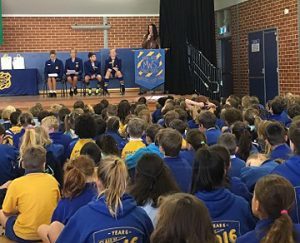
Talking in front of the whole school.
I won a competition too, along with my co-authors of ‘The Time of the Jade Spider‘, a short fantasy time-slip novel due to come out early next year.

I launched three other books in 2016 too: ‘Rider & the Hummingbird‘, ‘A Fearsome Engine‘ and ‘Into Tordon‘ (once in Sydney and, thanks to MidnightSun Publishing, once in Adelaide) – all collaborative projects – and I signed a contract for IFWG to publish my own book ‘Towards White‘ in 2017. Excitement! Click on the links to read more about those books or pop into your local bookshop and ask about them – you may even stumble across a signed copy!

On the short story side of things, the Hugo-finalist Sci Phi Journal published my fantasy story ‘Let the Tempest Hold Me Down‘ in its online magazine, and then again in its print anthology ‘The Journal of Science Fiction and Philosophy‘. My story ‘Like the Web of a Swamp Spider’ was included in ‘A Fearsome Engine‘. And ‘Darker’ was re-printed in ‘Dead of Night: The Best of Midnight Echo‘, an anthology of twenty-five stories from the first ten years of Midnight Echo Magazine, ‘a showcase of Australia and New Zealand’s darkest imaginations’! Follow the links to purchase!



 I went on a writing retreat and spoke there, taught the year-long course ‘The Year Your Book Gets Written’ along with countless other writing classes, including one to twenty teenage writers at Manly Library. I set dates for plenty more classes throughout 2017 too. I went to the NSW Writers’ Centre’s twenty-fifth birthday and won some books. I received my first email request for a signed copy of one of my books.
I went on a writing retreat and spoke there, taught the year-long course ‘The Year Your Book Gets Written’ along with countless other writing classes, including one to twenty teenage writers at Manly Library. I set dates for plenty more classes throughout 2017 too. I went to the NSW Writers’ Centre’s twenty-fifth birthday and won some books. I received my first email request for a signed copy of one of my books.

Finally, last month I signed with the Donald Maass Literary Agency in New York. My agent Cameron McClure and I are busy planning world domination and I can’t wait to get started! Bring it on, 2017!
What about you? Have you looked back at 2016 yet and made a list of any highlights?
November 30, 2016
I’ve signed with the Donald Maass Literary Agency in New York! Woo hoo!
 It’s official – I’ve signed with the Donald Maass Literary Agency in New York! Woo hoo!
It’s official – I’ve signed with the Donald Maass Literary Agency in New York! Woo hoo!
My agent is the fantastic Cameron McClure, who already has me editing manuscripts, conjuring up new stories and writing up a storm. It’s an honour to be working with such a professional, talented and intelligent agent whose sights are firmly set on breaking me into the US market.
I’ve had my eye on the Donald Maass Literary Agency since reading “Writing The Breakout Novel” by Donald Maass himself, many years ago. I made copious notes!

What I’ve always remembered was his idea that to keep your reader’s attention, you need to keep your writing at-tension. I love word play! He’s written other books on writing too, see here.
Cameron has been with the agency herself since 2004 and loves all the same kind of stories that I do – stories with good writing and voice, as well as a strong plot, original premise, both internal and external character conflicts, and narrative momentum. I’m thrilled to be working with her and excited to see what might come of it!
Thank you, Cameron! Thank you, DMLA!
Save
November 19, 2016
#RockstarAuthor Weekend: Sydney’s #AFearsomeEngine & Adelaide’s #IntoTordon
Books, books, books! This weekend has been a busy one, in a fabulously #RockstarAuthor way! On Friday night I launched “A Fearsome Engine” in Manly, Sydney; then I caught a plane to launch “Into Tordon” in Adelaide. Woo hoo – jetsetting! Lucky, lucky me.
Of course I thought of you guys the whole time – readers who couldn’t make it, supporters watching from afar. So I took you with me on my iPhone and snapped some piccies to share with you…
A Fearsome Engine

Who is the master and who the machine?
This collection of twenty stories by the incredible Northern Beaches Writers’ Group explores this question with horror, humour, pathos and philosophy. Whether it be in our own place and time, far in the future, the past, or in a universe of their own making, the stories grapple with the interface between humanity and its machines.
Are the things we make ours to command? Will they always be?
And who, exactly, is making whom?
I was so proud to help create this anthology with my co-editor, the talented Chris Lake. Here’s me thanking him during my launch speech:

And here’s us launching the book, along with some piccies of the crowd, and Carl Holm reading from his story, “Water Torture”.



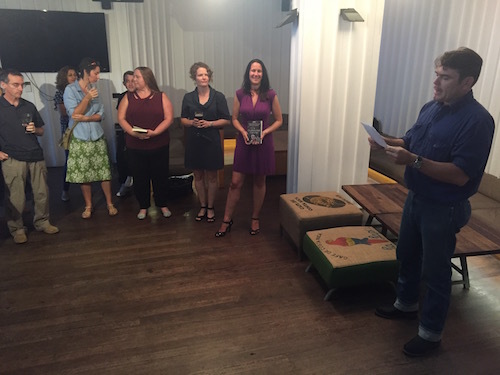
Carl Holm
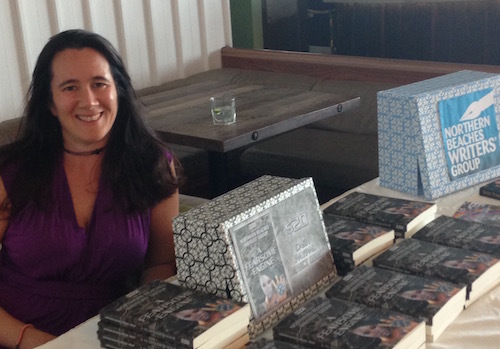
Time to sell books!


If you’d like to read the anthology yourself, just search for “A Fearsome Engine” in your preferred online bookstore, such as Amazon. It’s about $20, which means the stories are $1 each – what a bargain! My story in the anthology is called “Like the Web of a Swamp Spider”…
Friendship is about forgiving each others’ mistakes, and accepting others for who they are… only in some conditions that’s easier said than done. On a distant planet, with limited technology, her hillstead surrounded by swamp – Salee must face her worst fears.
I hope you enjoy the read. It was a really fun night!
I was up early the next morning though to get to the airport and fly to Adelaide with some of my co-authors of “Into Tordon”…
Into Tordon
 Only Champions Dare To Enter!
Only Champions Dare To Enter!
This fantasy adventure story for middle grade readers is certainly getting around!
A big thank you to the amazing Anna Solding of MidnightSun Publishing and the lovely Allayne Webster, author of Paper Planes, for launching “Into Tordon” at Shakespeare’s Bookshop in Blackwood, run by the very bubbly Mike and Becky. Four of my fellow co-authors made the journey too, and of course the others were with us in spirit, and we had such a fun time…

Arriving at Sydney Airport




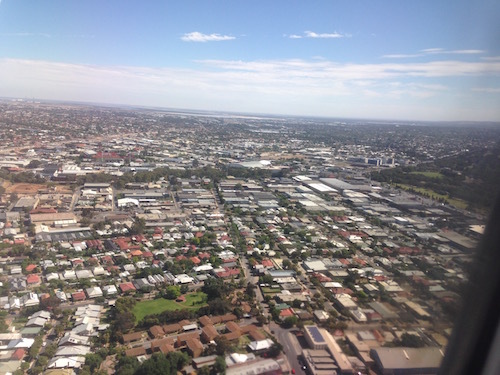
My first view of Adelaide

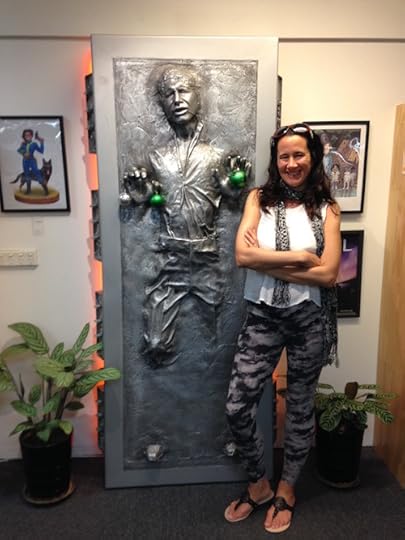
Look what we found in a comic store en route to the launch!

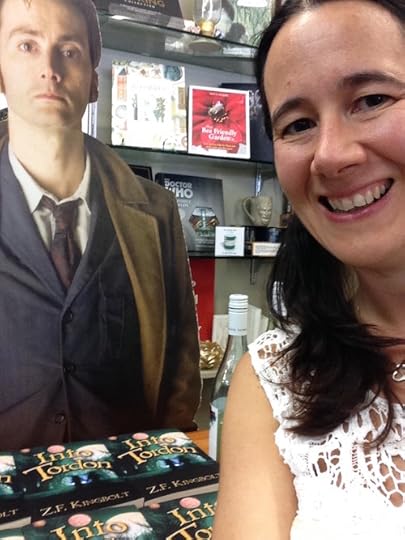
Great customer service in this bookstore!
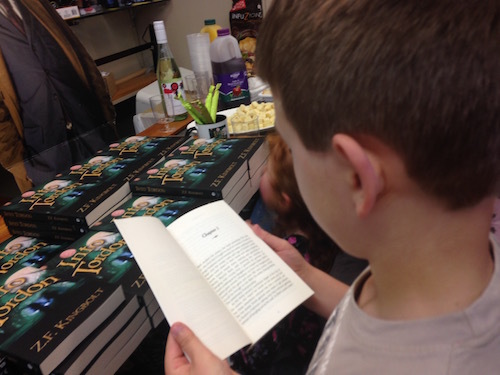
A young reader thought he’d read the first page…
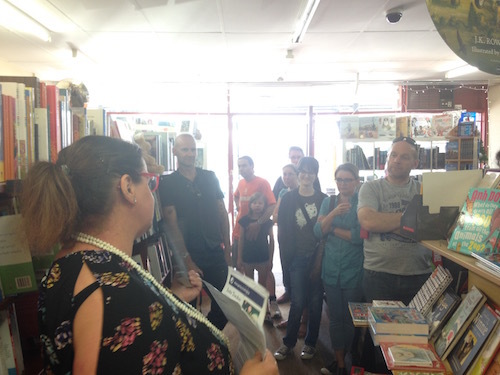
Allayne Webster
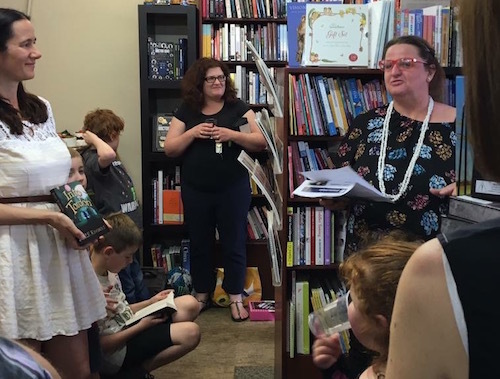
Allayne Webster & me.
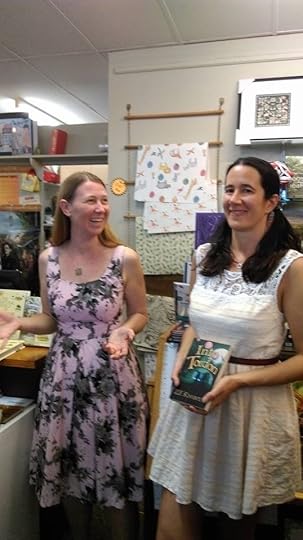
Publisher extraordinaire Anna Solding & me.

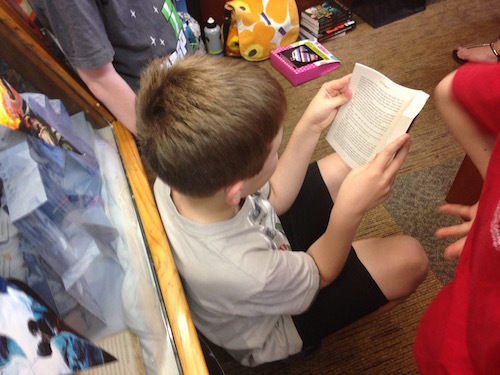
…that same young reader couldn’t put “Into Tordon” down!!
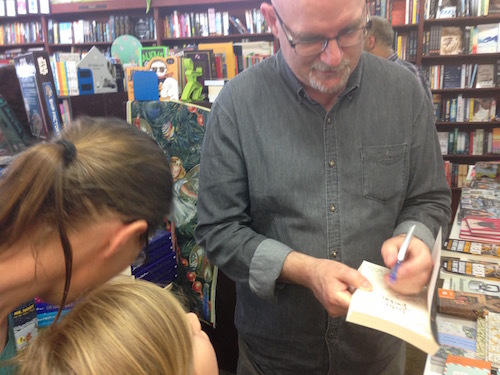
Tony signing books.
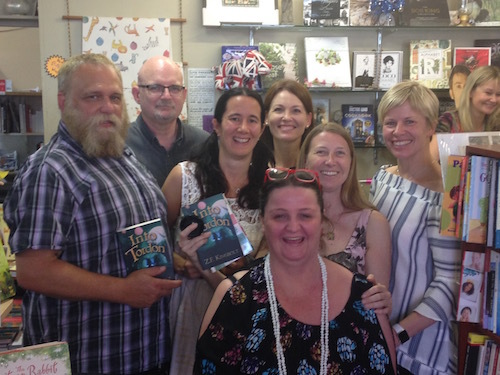
Mijmark, Tony, me, Zoya, Allayne, Anna, Kris
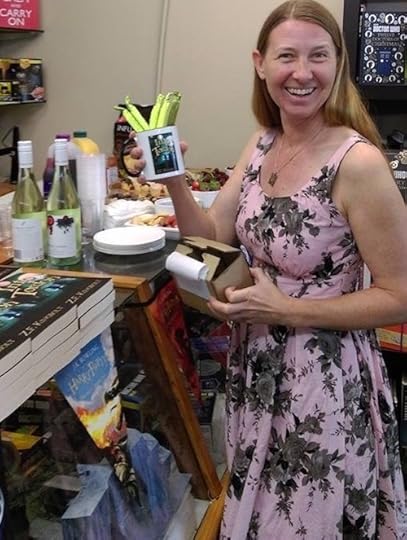
Merchandising!
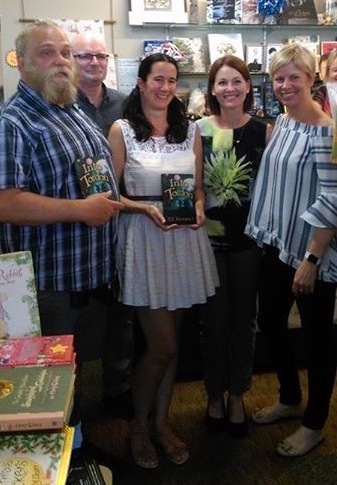
The Adelaide Z.F. Kingbolt crew!
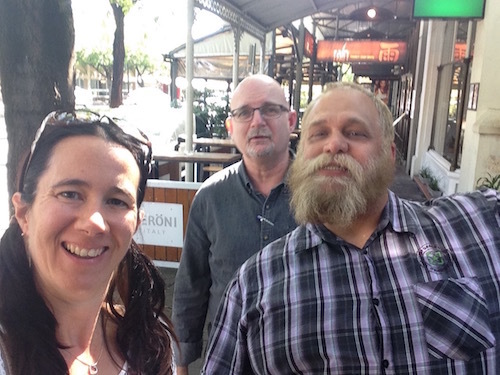
Heading out for dinner & drinks, then to the hotel!

The end of a long but amazing day!

Time for… sleep!
“Into Tordon” can be found in all good Australian bookstores, both on the high street and online. Kids are really enjoying the fast-paced ride, and as a parent I love it when my kids can’t put down a book… if you do too, try “Into Tordon” out on them!
Thank you as always for your support!
I’ve had an amazing weekend, though of course can’t wait to get back home to my little family… and my current writing project! Books, books, books!
November 12, 2016
How ‘Alice Campion’ co-wrote #ThePaintedSky and #TheShiftingLight
 As many of you know, I recently co-wrote a book with nine(!) authors (“Into Tordon” by Z.F. Kingbolt), so am particularly fascinated by collaborative writing at the moment. ‘Alice Campion’ is the pseudonym of several authors writing as one: Jane Richards, Jenny Crocker, Jane St Vincent Welch and Denise Tart. Their second book, “The Shifting Light”, is due to be released by Penguin Random House early in 2017. Their first novel “The Painted Sky” was also written with Madeline Oliver.
As many of you know, I recently co-wrote a book with nine(!) authors (“Into Tordon” by Z.F. Kingbolt), so am particularly fascinated by collaborative writing at the moment. ‘Alice Campion’ is the pseudonym of several authors writing as one: Jane Richards, Jenny Crocker, Jane St Vincent Welch and Denise Tart. Their second book, “The Shifting Light”, is due to be released by Penguin Random House early in 2017. Their first novel “The Painted Sky” was also written with Madeline Oliver.
Jenny Crocker is a communications manager who uses her work to create positive change in the world. She has been a journalist and non-fiction author and likes to escape to her small hazelnut farm in northern NSW.
Jane Richards is a senior editor and journalist at Fairfax Media. She loves mysteries and secrets.
Jane St Vincent Welch spent her childhood on a property in the New England region of NSW. She works in Sydney as a documentary editor.
Denise Tart is a marriage celebrant with a background in performance and event management. She has written for the theatre and business, but now mainly pens meaningful and romantic ceremonies. Denise loves a good yarn.
So how did so many authors go about collaborating over the writing of their awesome books? To find out, I asked Jane Richards…
When you write collaboratively, how do you make the decisions? Do you all have an equal say? What happens when there’s a stalemate?
We generally plot the ‘scenes’ together first and basically outline what is to happen – whose point of view the scene is to be written in and what emotions/reactions we want our characters to feel and express. We also outline how each character should ‘progress’ by the end of the scene – so when we present our writing there are no major surprises. But of course, one of us may be struck by an idea to make the scene work better or discover a discrepancy when they are writing that we haven’t thought of. If so, they will flag this to the group before the writing is presented. So basically we have quite a detailed outline of what we want and are expecting but we also are very willing to let the writer of that particular scene have the freedom to suggest additions. There have generally been few stalemates – and if we have one we put it to the vote. We all have an equal say, though we do take each other’s various expertise in certain things into account. Funnily enough the most disagreements we’ve had were way back when we were writing The Painted Sky and tackled our first sex scenes. These were quite robust and funny! Discussions about what sort of language was too anatomical or sexy/unsexy, etc. Hilarious now when we think of it!
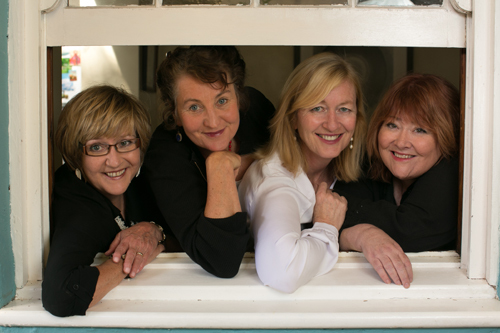
‘Alice Campion’: Denise Tart, Jane St Vincent Welch, Jane Richards & Jenny Crocker.
Did you agree that was how things were going be before you started writing, or did your working relationship evolve into that system, and were there any hurdles with that?
Our system evolved over time when we were writing the first book, but by the second book we had that system firmly in place and it was never questioned – mainly because it worked so well for us. None of us are shrinking violets and occasionally we’d have robust discussions but were also respectful of each other and are great friends so this helped. We had a couple of rules that we followed: namely we were honest with criticism but we also had to be specific, solutions focused and sensitive. For example it was never enough to say ‘that’s crap’ – we had to present a reason why something wasn’t working and present a solution. So we’d maybe say: ‘Character A sounds a bit gruff when he says this, I think it might work better if he says A B or C instead’.
With the collaborative writing I’ve done, it’s my job to ensure the story has a consistent voice and tone. With yours, does one person do a ‘voice’ or ‘tone’ edit, or do you write so similarly that a consistent voice and/or tone comes naturally, and have you experienced any hurdles with that?
For the first book this was a major concern. We managed it by each one of us rewriting each scene so, in essence, it was re-written at least five times (often many more times) by all of us. After each rewrite it was read aloud and suggestions and edits were made. We were thrilled when Random House told us they couldn’t believe it was written by five authors, and the same thing happened with the second book which was written by four of us. By the second book we had definitely found ‘Alice’s voice’ and the voices of the characters from the first book – and there was much less rewriting required.
How do you cope emotionally with working collaboratively, where egos and ideas must remain subservient to ‘the story’?
Writing collaboratively is a very different beast to writing individually so you have to enter the process with that in mind. We realised early on that in order to proceed we needed to leave our egos at the door and focus on one thing – producing a good book.
Which is the hardest part of collaborative writing for you – conceptual, writing, editing, production or marketing – and why?
We all have different skills and talents so it varies between the four of us. Writing and editing come quite naturally to me (I’ve been making a living out of both of these for 30 years after all.) I guess the publishing of our first book came as a big surprise and so the publicity and marketing attached to that was quite new to me – though Jenny Crocker has worked extensively in marketing, publicity and publishing so we drew on her skills somewhat here. I must say that publicising the book has been much more fun and less of a chore or less daunting than we expected and I think this is because we did this as a group. Much easier to travel to unknown places and give talks as a group!
What would be your biggest tip for anyone thinking of writing collaboratively?
Have a clear goal, emphasise that the process is not about each individual showing what they can do – it’s about a result!
How do you manage to present a united front when talking about your collaborative writing to the reading public? Do you agreed on what’s best to say or not say, such as protecting spoilers and being respectful of your fellow co-authors?
 We were quite careful early on to loosely structure our talks – we didn’t want to end up sounding like a rabble or start talking on top of each other. The other thing we were conscious of was that we had so many stories and anecdotes to tell that we didn’t want to forget any, so we loosely divided up who spoke about what. It’s funny but we all gravitated to telling different parts of our story. Re spoilers – we were very strict from the early days of publicising The Painted Sky – it’s a book with so many twists and turns that we didn’t want to ruin anyone’s experience. This can be quite tricky and The Shifting Light has even more twists so we have had to be very careful. We do reassure our audiences that if we do read a few passages we will ensure we give nothing away.
We were quite careful early on to loosely structure our talks – we didn’t want to end up sounding like a rabble or start talking on top of each other. The other thing we were conscious of was that we had so many stories and anecdotes to tell that we didn’t want to forget any, so we loosely divided up who spoke about what. It’s funny but we all gravitated to telling different parts of our story. Re spoilers – we were very strict from the early days of publicising The Painted Sky – it’s a book with so many twists and turns that we didn’t want to ruin anyone’s experience. This can be quite tricky and The Shifting Light has even more twists so we have had to be very careful. We do reassure our audiences that if we do read a few passages we will ensure we give nothing away.
Thank you so much Jane! “The Painted Sky” is available from all good bookstores right now! “The Shifting Light” is due for release through Penguin Random House in 2017. Here’s the blurb for “The Painted Sky“:
Nina never knew what happened to her father, the celebrated artist Jim Larkin. One minute he was her devoted dad, the next he’d disappeared without trace. Seventeen years later, she’s still haunted by the mystery. Until a call from outback Wandalla changes everything.
Interested in what other authors have to say about collaborative writing? I’ve also interviewed Margo Lanagan, Deborah Biancotti and Scott Westerfeld, and Alan Baxter and David Wood. Watch this space for those interviews!
Save







